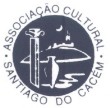| ROSSIO DA SENHORA DO MONTE
Classificação:
Cronologia:
Situação:
Propriedade:
Situação:
Propriedade:
Referencias:
Classification:
Chronology:
Situation:
Property:
References:
Classification: Palais
Chronologie: Seconde moitié du XIXe siècle
Situation: Rua dos Condes de Avillez (38o0'54.05''N; 8o41'51.03''W)
Propriété: Publique : municipale
Références : José Falcão e Ricardo Pereira, 1999.

Antes de começarmos a falar sobre este espaço, é importante fazermos referência à igreja que lhe deu o nome.
Pensa-se que a sua evocação era de Nossa Senhora da Natividade, que estava situada no local onde foi construído o edifício da Escola Primária (actual SRFUA , Sociedade Recreativa Filarmónica União Artística) .
O templo foi fundado pelo cavaleiro santiaguense João Estaço e construído entre a primeira metade do séc. XVI e o terceiro quartel da mesma centúria (V. Barata1993:30; Pereira e Falcão 1988:162,163; Silva 1869:57 ; Silva 1992:105). Aí, foi sepultado até à demolição da Igreja e foi transladado para o cemitério da Vila em 1923.
Este templo serviu de matriz durante as obras de reconstrução da Igreja de Santiago Maior (Silva 1869:57) , prova das suas médias dimensões, tendo uma só nave, cobertura interior de madeira e uma torre sineira construída em 1797. No ano de 1803, a igreja já se encontrava bastante degradada e inicia-se uma campanha de obras a favor da sua reconstrução e recuperação, nomeadamente no telhado do corpo da igreja, na capela -mor, no corredor, na sacristia velha e na sacristia nova (V.A.M.S.C., Livro de Registo de Arrendamentos dos Bens e Rendas do Concelho de 1 de janeiro de 1793 a 30 de julho de 1803:133,134).
Em 1858, com o terramoto que assolou o país inteiro e que se fez sentir fortemente em Santiago do Cacém, a igreja voltou a sofrer estragos fazendo avançar o seu estado de degradação.
Em 1922/23, o então executivo da Câmara Municipal toma a triste iniciativa de destruir o imóvel religioso, tendo utilizado para o efeito dinamite para apear a sua torre setecentista. Em 1923, no dia 17 de abril, há uma solene e pomposa transladação dos restos mortais do fundador para o cemitério municipal, onde hoje se encontram juntamente com a lápide sepulcral original. Tendo por base uma transcrição dum documento sobre receitas do Município, vimos que metade do terrado rendia para a Câmara 12$00 réis por ano. Há indicios que levam a supor que a outra metade do valor das receitas era para a Igreja e seria esta que instituiu a Feira do Monte.
A acta de 2 de maio de 1750 constatamos esta relação entre Igreja e Câmara na realização da feira:
“Os officiais da Camara propos a Igreja da adeministração da Camara e correr a fabrica della por conta da mesma e ter a mesma Igreja o rendimento da metade do terrado da feira que todos os anos que nela se faz digo que no Rocio da mesma Igreja se faz e a outra metade o Concelho.”
Através de outros documentos, podemos constatar que a Feira seria realizada a 8 de setembro, também o dia da festa da padroeira dela Igreja, que seria denominada popularmente pela Igreja da Nossa Senhora do Monte, por estar situada no cima de um monte, e ao seu isolamento em relação à vila que, nesse tempo, não devia ter descido muito pela encosta, desde o castelo em direcção ao vale.
Before we start talking about this space, it is important to make reference to the church that gave it its name.
It is thought that its evocation was of Nossa Senhora da Natividade, which was located on the site where the building of the Primary School was built (currently SRFUA, Sociedade Recreativa Filarmónica União Artística) .
The temple was founded by the knight from Santiago, João Estaço and built between the first half of the 20th century. XVI and the third quarter of the same century (V. Barata1993:30; Pereira and Falcão 1988:162,163; Silva 1869:57; Silva 1992:105). There he was buried until the demolition of the Church and was transferred to the Vila cemetery in 1923.
This temple served as a matrix during the reconstruction works of the Church of Santiago Maior (Silva 1869:57), proof of its medium dimensions, having a single nave, wooden interior cover and a bell tower built in 1797. In the year 1803, the church was already quite degraded and a campaign of works in favor of its reconstruction and restoration began, namely on the roof of the church body, in the chancel, in the corridor, in the old sacristy and in the new sacristy (VAMSC, Livro of Register of Lease of Property and Rents of the Municipality from January 1, 1793 to July 30, 1803:133,134).
In 1858, with the earthquake that devastated the entire country and was strongly felt in Santiago do Cacém, the church was once again damaged, furthering its state of degradation.
In 1922/23, the then executive of the City Council took the sad initiative of destroying the religious building, using dynamite for this purpose to demolish its 18th-century tower. In 1923, on April 17, there is a solemn and pompous transfer of the founder's remains to the municipal cemetery, where they are now found together with the original tombstone. Based on a transcript of a document on the Municipality's revenue, we saw that half of the land yielded 12$00 réis per year for the Municipality. There are indications that lead to the supposition that the other half of the revenue was for the Church and it would be this one that instituted the Feira do Monte.
The Minutes of May 2, 1750 confirm this relationship between the Church and the Chamber in the realization of the fair:
“The officers of the Camara proposed the Church of the administration of the Chamber to run its factory on its own account and to have the same Church the income of half of the fair's terrace that every year that is made there, I say that in the Rocio of the same Churchmakes and the other half the Council.”
Through other documents, we can see that the Fair would be held on September 8, also the feast day of the patron saint of the Church, which would be popularly called the Church of Nossa Senhora do Monte, as it is located on top of a hill, and its isolation from the village which, at that time, must not have gone far down the slope, from the castle towards the valley.
Avant de commencer à parler de cet espace, il est important de faire référence à l'église qui lui a donné son nom. On pense que son évocation était de Nossa Senhora da Natividade, qui était située sur le site où le bâtiment de l'école primaire a été construit (maintenant SRFUA, Sociedade Recreativa Filarmónica União Artística) .
Le temple a été fondé par le chevalier de Santiago, João Estaço et construit entre la première moitié du 20e siècle. XVI et le troisième quart du même siècle (V. Barata1993:30; Pereira et Falcão 1988:162,163; Silva 1869:57; Silva 1992:105). Là, il a été enterré jusqu'à la démolition de l'église et a été transféré au cimetière de Vila en 1923.
Ce temple a servi de matrice lors des travaux de reconstruction de l'église de Santiago Maior (Silva 1869:57), preuve de ses dimensions moyennes, ayant une seule nef, une couverture intérieure en bois et un clocher construit en 1797. En 1803, l'église était déjà assez dégradée et une campagne de travaux en faveur de sa reconstruction et de sa restauration a commencé, notamment sur le toit du corps de l'église, dans le chœur, dans le couloir, dans l'ancienne sacristie et dans la nouvelle sacristie (VAMSC, Livro du Registre du Bail des Propriétés et des Loyers de la Commune du 1er janvier 1793 au 30 juillet 1803 : 133 134).
En 1858, avec le tremblement de terre qui ravagea tout le pays et fut fortement ressenti à Santiago do Cacém, l'église fut à nouveau endommagée, accentuant son état de dégradation.
En 1922/23, l'exécutif de la Mairie de l'époque prit la triste initiative de détruire l'édifice religieux, utilisant à cet effet de la dynamite pour démolir sa tour du XVIIIe siècle. En 1923, le 17 avril, il y a un transfert solennel et pompeux des restes du fondateur au cimetière municipal, où ils se trouvent maintenant avec la pierre tombale originale. Sur la base d'une transcription d'un document sur les revenus de la Municipalité, nous avons vu que la moitié du terrain rapportait 12$00 réis par année pour la Municipalité. Il y a des indices qui conduisent à supposer que l'autre moitié des revenus était pour l'Église et que ce serait celle-ci qui institue la Feira do Monte.
Le procès-verbal du 2 mai 1750 confirme cette relation entre l'Église et la Chambre dans la réalisation de la foire :
«Les officiers de la Camara ont proposé à l'Église de l'administration de la Chambre de gérer son usine à son propre compte et d'avoir à la même Église le revenu de la moitié de la terrasse de la foire que chaque année qui s'y fait, je dis que dans le Rocio de la même Église fait et l'autre moitié le Concile.
À travers d'autres documents, nous pouvons voir que la Foire aurait lieu le 8 septembre, également jour de la fête du saint patron de l'Église, qui serait populairement appelée l'Église de Nossa Senhora do Monte, car elle est située au sommet d'un colline, et son isolement par rapport au village qui, à cette époque, ne devait pas descendre bien loin de la pente, du château vers la vallée.


